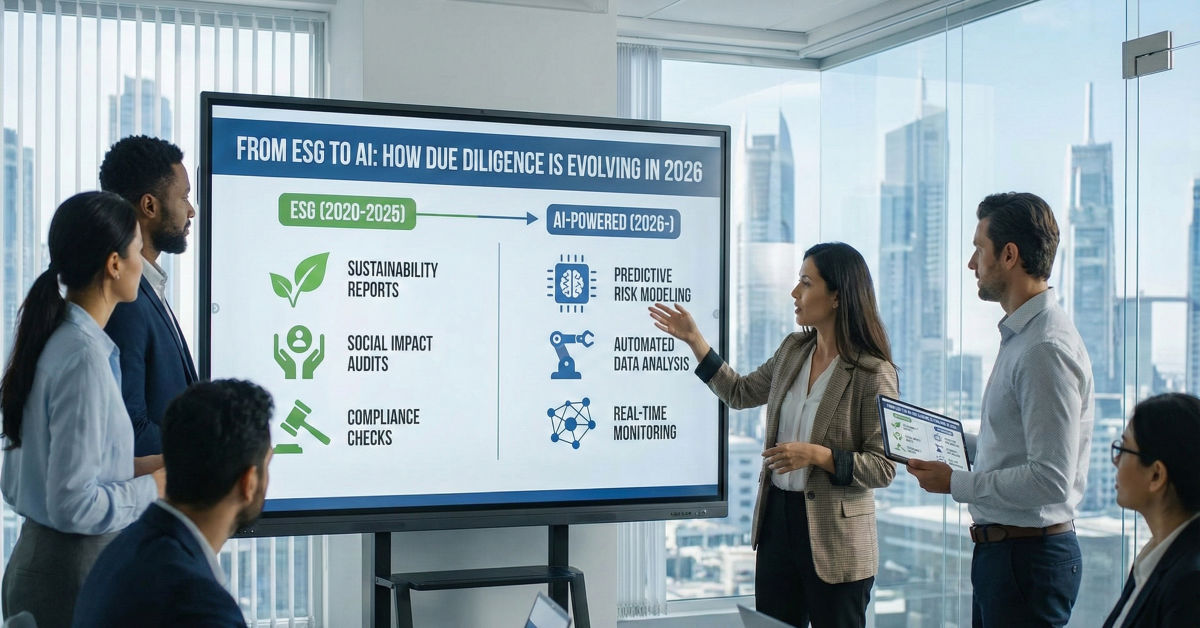The investment and corporate responsibility landscape is changing rapidly under our feet. Such reliance on financial audits is no longer sufficient; sustainable growth cannot be achieved without an in-depth understanding of ESG (environmental, social, and governance) dimensions. Amidst this changing landscape, Due Diligence has transformed from being a box-ticking exercise to becoming a strategic imperative. “But standard methods are finding it difficult to keep up with the necessity to continuously update existing data.”
This blog examines how Artificial Intelligence (AI) is revolutionizing this important process so you can transition from reporting on the past to predicting and acting in the future.
The Current State of ESG Due Diligence
The current evaluation process is messy for many investment firms and companies. It can also mean drowning in spreadsheets, tracking down PDFs, and attempting to make heads or tails out of fragmented data that’s dispersed across separate departments.
The fundamental issue is not typically the absence of data; it’s chaos. Some studies indicate that anywhere from 60% to 80% of a data organizations time is spent just cleaning up the data and getting it into a usable form for analysis.
The Challenges of Fragmentation
Data silos form when data comes from multiple disconnected sources, like email surveys, standalone software tools, or manual document uploads. You could have metrics around carbon in one place and diversity policies in another. This fragmentation makes it next to impossible to confirm or deny claims or gain a comprehensive view of the situation. In addition, quantitative measures alone do not explain the “why” of the data. In the absence of qualitative evidence, most ESG measurement is more akin to storytelling than proof.
AI’s Role in Transforming Due Diligence
This is where the next wave of technology comes into play; machine learning is not just automating old patterns, it’s re-imagining them. By embedding AI into data collection, we can already guarantee clean, organized, and ready-for-audit information from the start.
Enter Sopact Sense
Players like Sopact Sense are championing this, and centering their work on taking a “clean at source” approach. Instead of waiting until the reporting period’s end to rectify errors, the system keeps tabs on every single stakeholder and data point through unique identifiers.
It is at that level of granularity that governance matters. For instance, when exposing a complex supply chain, you have to follow some specific verified entities. And, when verifying corporate registrations or reviewing SIM owner details for safe, mobile-based field audits, AI connects all evidence to the proper source. That has the advantage of filtering out duplicates and making sure that qualitative From ESG to AI (in the form of, say, policy documents) is considered along with quantitative metrics.
Key Benefits of AI in ESG Due Diligence
Using an AI-based methodology delivers immediate benefits to finance professionals and compliance specialists. The idea is that you’d spend less time doing things manually and more time making strategic decisions.
Speed and Real-Time Insights
The traditional due diligence can take weeks or months. By the time a report is finished, the data can be stale. AI accelerates this timeline significantly. With tools like Sopact Sense, you can build and deliver a rigorous process within weeks, not months. In the world of business, real-time decisions require real-time insights, which can only come from AI.
Improved Accuracy and Reduced Costs
Because by automating the reading of thousands of documents, AI makes human error less likely. It can scan 100-page reports in minutes, parsing key themes and scoring them against benchmarks set by experts. This not only increases the performance but also significantly reduces the cost of manual review.
Comparing Traditional vs. AI-Powered Due Diligence
| Feature | Traditional Due Diligence | AI-Powered Due Diligence (Sopact Sense) |
| Time to Insight | Weeks or Months | Minutes |
| Data Quality | Fragmented & messy | Clean-at-source & organized |
| Analysis Type | Manual & siloed | Simultaneous Qual + Quant analysis |
| Evidence Linkage | Difficult to trace | Every score is linked to the source evidence |
| Update Cycle | Static annual snapshots | Real-time, living intelligence |
The Future of Investment Analysis
As we approach 2026, AI adoption in ESG will be standard industry practice. The days of depending on unverified surveys and disconnected spreadsheets are limited.
Investment analysis, to remain competitive, needs to be based on evidence. Being able to take qualitative context, the “narrative,” and corroborate it with AI gives a level of transparency that today’s investors need. With the right tools for clean data and automated analysis, you can turn due diligence from a cost center into a competitive advantage.







